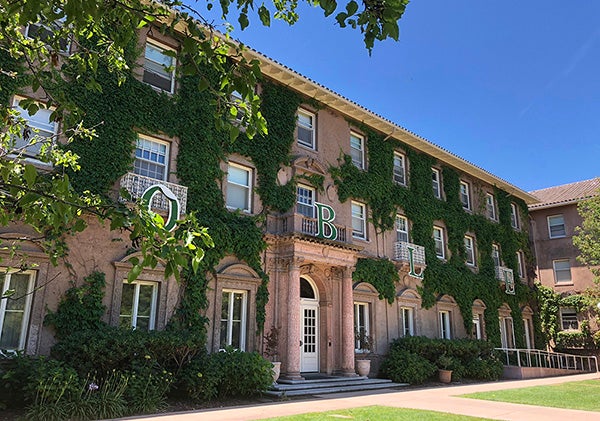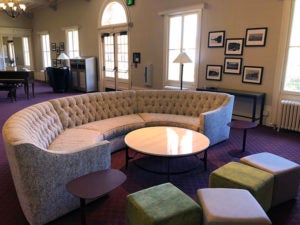Roble Hall celebrates 100 years as a student residence

Roble Hall, the oldest continuously used residence hall on the Stanford campus, turns 100 this fall.
Much has changed at Stanford since Roble opened as a women’s residence on Sept. 28, 1918. But even as the campus has grown up around it, the ivy-covered Beaux-Arts icon has remained relatively unchanged. It still houses students – although today it is co-ed – in three wings located alongside Lake Lagunita on the west side of campus.
At the time of its construction, Roble was considered one of the most up-to-date residences in the country, with its emphasis on homelike, group-living spaces for socialization. Such amenities were considered novel for the day, but essential for women students. So Roble boasted dining rooms, a spacious parlor and lobby, a second-floor library and special-interest rooms. When it opened, Roble housed 154 students.
Named for the valley oak trees sprinkled throughout campus, Roble today houses about 300 students. Although a four-class facility, Roble is actually Stanford’s largest first-year residence, accommodating about 150 freshmen in quadrangles that feature two-person bedrooms linked by a common living and study space with a window alcove.
A history worth discussing
Roble’s history will be the subject of a discussion on Oct. 11 organized by the Stanford Historical Society and by resident fellows Jeff Ball and Becky Bull. Ball serves as scholar-in-residence at the Steyer-Taylor Center for Energy Policy and Finance and as a lecturer at the Law School. The discussion will feature James Campbell, professor of history, and Laura Jones, director of heritage services, university archaeologist and president of the Stanford Historical Society.

The discussion, Ball said, will focus on how Roble’s history has mirrored that of the university itself. Although built originally to house women who were not members of sororities, it has played a key role in meeting Stanford’s mission of fostering inclusivity. All the while, it has endured earthquakes and been modernized through renovations. Today, it is home to the Roble Living Laboratory for Sustainability at Stanford, or ROLLS. That means Ball and Bull oversee Roble programs focusing on sustainability – a pertinent concern for today’s college students.
Roble is distinct because of the way its residents – from the first women students to current undergraduates – create a culture of egalitarianism based on community, according to Jones.
“There used to be this sort of unfortunate social division between hall women and sorority girls,” Jones said. “The hall women in Roble were generally considered to be more serious students – a little bit nerdier – and that comes through in yearbooks and the Stanford Daily. They wore it like a badge of honor. They were very deliberate about not being the last choice in housing – in other words, they were aggressively egalitarian.”
Jones said the independent women of Roble served as a counterpoint to the exclusivity that tended to define Greek life. Over time, that egalitarianism, nurtured by generations of both male and female Roble residents, has helped create the Stanford culture of today, which celebrates inclusivity and community with healthy doses of nerdiness and irreverent humor.
In her research, Jones discovered a 1977 Stanford Daily photograph of the Roble Rotagilla Club – alligator spelled backward – that supports the point. Dripping with irreverent humor, the photograph portrays students in white cricket outfits pretending to be pretentious members of an exclusive Roble club that celebrates “cricket, croquet and cocktails.”
“That’s the part that I think is interesting about Roble,” Jones said. “The first residents spent a lot of time building community and making the hall a fun place to live with an endless series of activities. So Roble became a very intentional place to live – and that ethos continued even as the hall became co-educational.”
The first Roble
The facility, which sits just beyond the Papua New Guinea Sculpture Garden at the corner of Santa Teresa Street and Lomita Drive, is not the original Roble Hall. The first Roble, opened in 1891 on Serra Street, was intended to complement the all-male Encina Hall on the east side of campus. That building has since been demolished.
The current Roble emerged as part of a broader expansion of the university and was envisioned by its architect, George Kelham, as having two H-plans side by side. Ultimately, only one H was created out of wings now referred to as A and B. The middle wing, which houses upper-class students, connects to the A and B wings. But the C wing is connected to the other wings only on the first floor. The residents of C wing’s second and third floors are, even a century later, left oddly – but perhaps proudly – separate from the rest of the building.

Courtesy Stanford University Archives
During its early history, life in Roble was relatively formal, with special attention paid to protecting the virtue of Roble women. They were subject to curfews and strict restrictions on male visitors. Marie Wagner Krenz, ’47, MA ’48, described some of the rules to Stanford magazine in a 1971 article.
“On weeknights, we had to be in by 10:30,” she wrote. “We lived under an elaborate regimen of sign-ins and sign-outs, and the worst sin of all was a lockout. Mrs. Mort locked the great front door promptly at closing time and greeted any offender with an expression of horror for being even one minute late. Repeat offenders received notice of a command appearance before Women’s Council. A friend who served on that august body remembers a chronic latecomer who defended herself with a question of her own: ‘Weren’t you ever in love?’”
By 1968, Roble became co-ed, with men and women’s living spaces separated by floors. By the 1970s, the university opted to use Roble to meet the needs of members of student minority ethnic groups who sought common living accommodations. Roble for a period of time included residential space for African American, Latino/a and Native American students who wanted to live together.
In 1987, Roble was briefly closed when it became clear its hollow ceramic tile walls were unlikely to survive an earthquake. Its residents became known as “Roble refugees” as they were scattered to temporary quarters in residences across campus. The seismic upgrade paid off. Roble was relatively unscathed in the 1989 Loma Prieta earthquake, which occurred just weeks after renovations were finished.
Since then, Residential & Dining Enterprises has continuously invested in the iconic building, spending $17 million to renovate during the summers of 2005 and 2006. That renovation resulted in the discovery within a wall of a historic photo of a young man with an inscription reading “Janet, Night and Day, Justin” – no doubt a romantic reference to the famous Cole Porter tune. Four original Corinthian column capitals, which had been abandoned in the basement of B wing, were also found.
Roble allegiance
As a resident fellow, Ball has seen firsthand what he calls the “incredible allegiance” alumni of Roble feel for their former home. Last year, he and Bull hosted a gathering during Alumni Weekend that attracted about 75 people.
“Their stories were amazing,” said Ball. “There was one alumna who remembered when there was a dining hall in Roble, with all the tables covered by white tablecloths.”
Affection for Roble remains strong, as well, for relatively recent alumni.
“I got goosebumps when I visited Roble for my fifth-year reunion,” said Brian Aguado, who graduated in 2010 and is now a National Institutes of Health postdoctoral fellow at the University of Colorado.
“Roble means so much to me; it is so much more than my home as a freshman. I can pinpoint so many moments when I started to figure myself out both professionally and personally while I lived in Roble. The people I met along the way influenced me and my life in so many positive and unexpected ways. It’s also amazing to see Roble-mates when I travel and be able to pick up immediately where we left off without skipping a beat.”
The architecture of Roble, considered novel for its time, helps explain those close friendships. Here is how the architecture works its magic: First-year students in a quadrangle build close friendships with their quad mates. With the help of resident assistants, those relationships grow into an affinity among students living on each floor. The floor friendships, in turn, become an association among fellow wing residents. Eventually, the wings come together to create a thriving 300-person community through shared residence experiences.
“It was a place that felt like home,” remembers Anne Gomez, a senior program manager at the Wikimedia Foundation who graduated in 2009 and lived in Roble for three of her four years at Stanford. “The quads for freshmen and the ways the halls were set up created bonds that still last.”
Continued investment
Whatever the secret is to Roble’s winning formula, it’s one that continues to attract investment from Residential & Dining Enterprises.
This summer, the building received yet-another facelift with the addition of a “makerspace” in one of the two large common rooms on the first floor. Both were once dining halls. The other common room is a theater where performances and talks are frequently featured.
Also this summer, all new furniture was installed in the lobby. Unsightly backyard garages were torn down and replaced with an open area that serves as what Michael VanFossen, executive director of R&DE maintenance operations and capital projects, said are outdoor gathering areas for students.
These updates added to two significant improvements over the past two years: an organic garden on Roble’s east side and the renovation of a courtyard in the rear of the dorm that houses twice-monthly barbecues to welcome the next generation of Roble residents.
